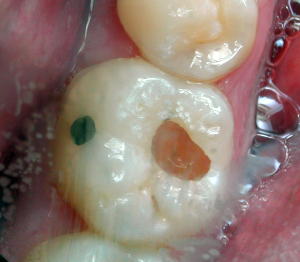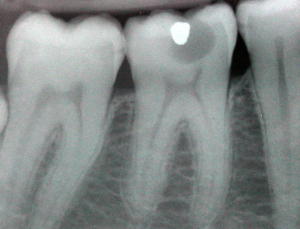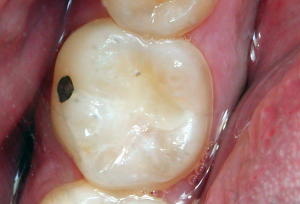Forums › Laser Treatment Tips and Techniques › Hard Tissue Procedures › getting into newsbreaker territory
- This topic is empty.
-
AuthorPosts
-
whitertthSpectatorroutine occlusal, deep decay , waterlase 5.5 watts for anaesthsia, did most of the dentin work at 2.5 watts, with some round bur for the deep mush…patient started feeling it only at the end, but was ok and I was able to complete without anaesthsia…note the radiograph and proximity to the pulp….



whitertthSpectatornow the post op…..

SwpmnSpectatorRon:
That’s pretty cool, thanks for sharing.
How old was the patient?
Al
SwpmnSpectatorAlso Ron:
Did you remove all caries? John Kanca is now recommending that rather than get a carious pulp exposure on a lesion like this, we leave the last layer of caries and “Simply”(pun intended if you follow his work), bond over the caries.
What dentin bonding technique did you use? Total etch with phosphoric acid or self etch bonding agent?
Any liner, e.g. glass ionomer? Flowable composite over the dentin bonding agent?
We use self-etch bonding agents exclusively with flowable composite as first layer after SE bond. Would like to get an idea on what you are finding successful after Erbium laser treatment.
Al
Robert GreggParticipantHi Ron,
Nice case and thanks for sharing.
Hey Al–am I the only one old enough to remember that decay has a “bacteria free zone” in the last 2mm near the pulp and that decay like this was treated with a “indirect” pulp cap using Ca(OH)2 (because decay was left behind) in order to obtain secondary dentin of the remaining soft stuff. Then a few months later, the ZOE was removed and a “final” restoration was then placed after a calcium bridge had formed.:confused:
Admittedly, I have never done this, but isn’t this “New Think” really “Old Think”
 :confused:
:confused:Bob
AnonymousGuestQUOTEQuote: from Swpmn on 7:10 pm on Mar. 25, 2003
Also Ron:Did you remove all caries? John Kanca is now recommending that rather than get a carious pulp exposure on a lesion like this, we leave the last layer of caries and “Simply”(pun intended if you follow his work), bond over the caries.
Al
Al, here’s probaby the most famous arguement for what Kanca is now saying–
J Am Dent Assoc 1998 Jan;129(1):55-66 Related Articles, Links
Comment in:
J Am Dent Assoc. 1998 Apr;129(4):410, 412.Ultraconservative and cariostatic sealed restorations: results at year 10.
Mertz-Fairhurst EJ, Curtis JW Jr, Ergle JW, Rueggeberg FA, Adair SM.
Department of Oral Rehabilitation, Medical College of Georgia, School of Dentistry, Augusta, USA.
Changes in restorative techniques and the development of newer restorative materials have allowed for the use of more conservative cavity preparations. This 10-year study evaluated bonded and sealed composite restorations placed directly over frank cavitated lesions extending into dentin vs. sealed conservative amalgam restorations and conventional unsealed amalgam restorations. The results indicate that both types of sealed restorations exhibited superior clinical performance and longevity compared with unsealed amalgam restorations. Also, the bonded and sealed composite restorations placed over the frank cavitated lesions arrested the clinical progress of these lesions for 10 years.
Publication Types:
Clinical Trial
Randomized Controlled TrialI have also seen on previous mission trips, glass ionomer placed over deep decay that arrests the decay progress.
Somewhere, I have an AGD CE tape from the late 80’s , early 90’s that recommended this radical change in thinking.
These things combined convince me to place glass ionomer if I have any doubts as to caries removal/possible exposure.…. and Bob, you’re not the only one who remembers ‘indirect’ pulp caps. I read about them in my dental history book

(just kidding-I did more than a few of those)
Glenn van AsSpectatorRon: gosh it is hard for me to let go of old ideas.
I really like your treatment…clap clap clap
Great photos and a nice result. Boy have I got a cool case coming soon that I dont even think our poster boy Mark Colonna has done.
Cant tell you yet but you are gonna flip when I do it.
I really wonder about bonding onto soft decay as some propose. It looks bad on radiographs and in general I hate it .
In this case you sure did a nice service to the patient.
I also wonder sometimes when the lesion is as undermined as yours was if there is a value to going back and widening the enamel up with a high speed diamond to prevent the weakened enamel from breaking.
Who knows but great clear photos.
Glenn
whitertthSpectatorthanks guys….all decay was removed …i use total etch with phosphoric acid, hurriseal, cabrio, matrix flowable(discus) for the bottom layer and simile for the remaining…. patient wasnt sensitive at all….i am starting to consider bonding over the last layer of decay…curious as to what malpractice ramifications it may have in a court case…..regards
SwpmnSpectatorBob and Ron(Schalter):
Ha ha ha!!!!! Thanks for your comments. I’m in the process of becoming an old fart also – we received similar training on “indirect pulp caps” at the University of Florida in 1985. Nothing particularly new proposed by Kanca and he does reference the study you mentioned Ron.
Like you said Bob, “Admittedly I’ve never done this”, but I’m rethinking removal of near pulpal caries and wondering if others are doing this with success.
Al
AnonymousGuestQUOTEQuote: from Swpmn on 11:32 pm on Mar. 25, 2003Like you said Bob, “Admittedly I’ve never done this”, but I’m rethinking removal of near pulpal caries and wondering if others are doing this with success.
Al
Al, whenever possible I remove all decay. When I think we will have an exposure I tell the patient we can do a couple of things( before even starting restorative procedure).
1. proceed and remove all decay, expose the nerve and be assured the will need RCT
2. get as close as possible to the nerve w/o exposing , place calcium hydroxide and then GI to try and get the tooth to use its natural defense mechanism to build up secondary dentin. they are also told that this tooth still may need endo.
3. direct pulp cap
Very few opt for endo right off the bat. I very rarely will do a direct pulp cap anymore due to high failure rate in my hands. I have done a couple since the laser and so far, so good. Over several years I’ve had more teeth treated as number 2 not go on to endo than have gone on to endo. If it works you’re a hero for avoiding an endo and if it doesn’t the patient is still happy you tried to avoid endo for them. I think the key is to get them involved in your thinking process so they understand what you are trying to do for them.
Glenn van AsSpectatorRon : I looked back at your case again, and really want to congratulate you for your fine treatment.
I think I would have done the DO on the premolar and the MO on the 2nd molar at the same time (they are dentinal) and checked to see if either proximal surface on the tooth you restored was involved. I just find so often with the scope that the first molar will have a cavitation not visible on the radiographs but present all the same .
1 year from now you are gonna have to do it anyways.
What is your feeling on this.
Thanks again.
HIgh caries rate in this individual.
Oh ya ……the little stain in the distal groove is something I will open up as well under the scope as it is often decay.
Again, dont get me wrong…….I LOVE WHAT YOU DID, just trying to provoke some more discussion on a nicely handled case.
glenn
whitertthSpectatorgreat post glenn….patient couldnt afford treatment so we only did the one that hurting of course……they r planned for the future…i got to tell u guys i love this board…. almost time for a meeting of our own say in the carribean? ………
2thlaserSpectatorNice stuff. Ok Glenn, now what did I do to deserve the name poster boy?
 Geeze! I am very sick today with the flu, had to cancel all my patients, man, terrible.
Geeze! I am very sick today with the flu, had to cancel all my patients, man, terrible.For you guys wondering about those “close calls” to the pulp, that is precisely why I use the spoon excavators as much as I do. I find I rarely ever expose due to caries removal, and I have wonderfu control of the situation when I am that deep. Glenn, how do you like using the instruments so far? I really am wondering how they feel in your hands.
I have a few cases to post, and am very sorry I haven’t been online as of late. I just got back from Europe last week, and am headed for London next Thursday. Finally, no more trips planned for at least 2 months after this next one. Keep up the great work everyone.
As for the direct pulp cap thing, we were taught that as well, CaOH, etc…now, I just lase it, and like everyone else, GI works great, and I am doing less endo. As for the undercut enamel Glenn, I find, especially after asking Stu, and Kim Kutsch about it, that with today’s materials, the strength is there to conserve tooth structure, and honestly, I haven’t seen any “cracked” or broken enamel, or cusps. That being said, let’s see how this all works out 10 years from now.
Hope everyone is doing better than I am!
Mark
PatricioSpectatorMy 2 cents,
I never expose the pulp if I can avoid it. I remove all possible decay. Usually this means I peal the decay down to a more durable cap of tissue just over the pulp chamber at that point if the tooth has been free of symptoms of pulp damage I place a base and restore the tooth. Over many years this has been a reasonably successful treatment. If I were planning a crown I would probably recommend a root canal treatment instead. I feel this is conservative and cost effective for the patient with a high potential for long term success. Now of course I laser the residual dentin over the pulp to decontaminate and sterilize before the base.
BenchwmerSpectatorI went to Dentin Bonding Agents as my pulp cap in 1995 (Kanca & or Bertolotti methods), acid etch, then DBA, then Flowable compsite, then bonded composite restoration. Threw away the Calcium Hydroxide.
Since 1999, Nd:YAG laser to remove the remainder of caries when see pink, if exposure cauterize w/ Nd:YAG, then Etch,DBAs, Flowable.
Now Nd:YAG, Self-etching DBA (I-Bond or One-Up bond), Flowable.
4-6 months later some fail, I blame on carious exposures, with CaOH techniques most would fail, many within days.
Not a reason to buy a Nd:YAG, but another use for the tool if you have one.
Jeff -
AuthorPosts
